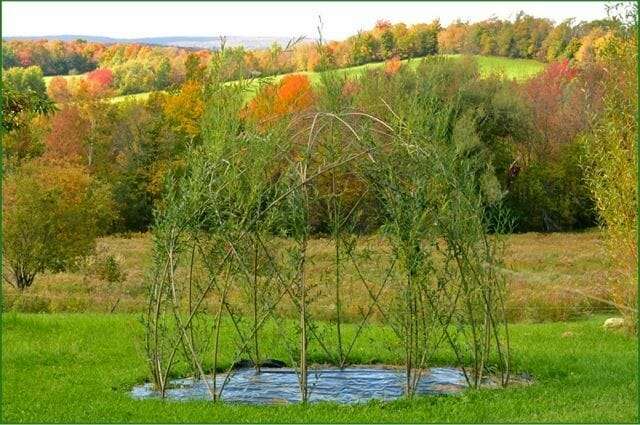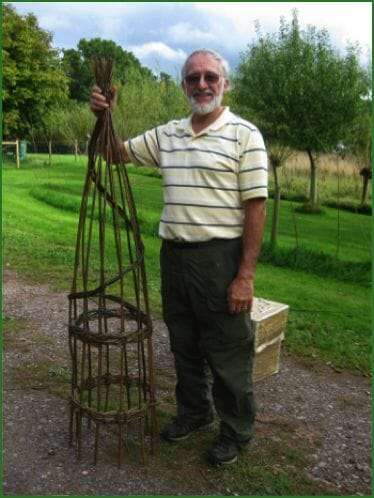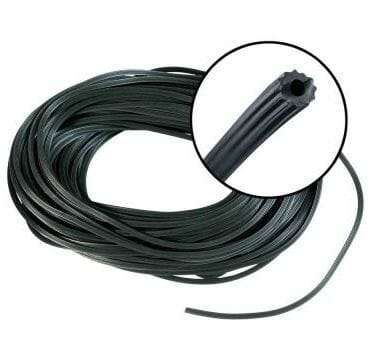creating living willow structures, with michael dodge

A little about Michael:
“That’s Michael Dodge,” I say, when I show people around the fall garden, as we pass a large group of show-offy, yellow-fruited Viburnum I enjoy all fall into winter. V. dilatatum ‘Michael Dodge’ is truly a standout plant.

Michael moved on to further adventures, many of them with his camera in hand, but most recently it all led to his version of retirement: collecting and then disseminating 250ish species and varieties of the genus Salix, or willow.
His company, called Vermont Willow Nursery, looks more like a full-blown nursery to me than retirement. We chatted on my public-radio show and podcast, discussing willows for a range of uses, from getting the garden off to extra-early bloom, to crafting living structures (top and below, a dome at Michael’s home, in active growth and before leafing out), and taking a stern hand when pruning.
Read along as you listen to the Feb. 2, 2015 show using the player below. You can subscribe to all future editions on iTunes or Stitcher (and browse my archive of podcasts here).
Plus, at the bottom of the page: Michael’s secret “twine” for use when tying up woody plants. (Why didn’t I know about this decades sooner?)
listen/read: willow q&a with michael dodge
Q. You know a lot of genera of plants from your long career in horticulture…so why willows now? How did you get to the willow stage of your career, Michael?
A. It’s very simple: When we moved to Vermont, we bought a house on 50 acres of wet clayey-loam soil.
Then we went to the Montreal Botanical garden, which is 60 miles from us, and there was an exhibition of living willow structures—and we had no knowledge of them until that point. We were just blown away by the display, as we had no knowledge of this art form. I was immediately addicted to willows. We went to England the next spring, and visited several willow nurseries, and learned all about willows.
Q. When you say “we,” you mean you and your wife, yes?
A. Yes. She’s not a horticulturist, and she thinks I’m insane.
Q. But she loves you anyway? [Laughter.]
A. Oh, of course.
Q. So it was those acres and acres of wet clay that said to you, “I need an ambitious grower; something that’s cooperative.”
A. There were a number of native willows growing on the property, and at that time I could not tell one willow from another. Later I discovered that there were seven different species, once I studied them.
Q. If you had to give us the elevator pitch on the genus Salix, the quick promotional pitch, what would you say about it—besides that it includes plants that have a tolerance of wet clay?
A. Willows are exceptionally easy to propagate and grow. They’re also one of the most diverse species of plants in the temperate world. They grow into immense, 100-foot trees, and last summer I climbed Mount Adams in New Hampshire to see a willow that was only 1 inch tall.
Q. You’re kidding; an inch?

[Above, Michael studying Salix x peasei (herbacea x uva-ursi), the rarest willow in the United States, and only found in that location. Photo by Julia Kozovkina PhD, University of Connecticut.]

[For glossy-leaved choices such as S. pentandra ‘Patent Lumley’, shown, look under “Showiest Foliage” on this page at Vermont Willows.]
Q. We’ve mentioned willows for wet clay, and willows on top of a mountain in New Hampshire, but are there willows for all climates, or do they not “do” in some zones?
A. They’re mostly temperate; there are native willows that grow in all states except Hawaii. Every other state has willows—even Florida, California and Arizona.
I’m speaking from New Mexico right now, and willows do grow here. There are both native willows, perhaps 20 kinds, mostly on the mountains; also you see European species and Chinese species growing in people’s gardens. You see weeping willows here that are 40 or 50 feet tall–in New Mexico, with just 10 inches of rain a year. How they survive, I do not know.
Q. The golden weeping willow that’s the common tree we see—where is that native to?
A. The one that you see mostly is actually a hybrid between Salix alba (from Europe) and Salix babylonica (from China).
Q. I actually love seeing them in late winter, before anything else has leafed out, with their yellow twigs. I’m not as crazy about how messy big old weeping willows are in a garden setting, but in late winter…
A. They do have that reputation for messiness. But when you’re driving through New England especially, you see these golden trees, and everything else is either green or brown or gray, and those are the brightest thing around.
So you can grow willows all over the country, especially in the northern half.
Q. You have a whole range of suggested uses for willows on the website. What are some that seem to draw your customers most? I first added willows for their colorful twigs—like I do the twig dogwoods—and then for very early flowering for sustaining the first pollinators awakening in my Zone 5B area.
A. One of the most frequent things that bring people to us: for fences, fedges and screens. They want to block out their neighbors, or block out something ugly, or prevent the deer from coming in. Some of the willows are so bitter to the deer that they won’t eat them: Any Salix purpurea variety, for instance, is inedible to deer. [Salix triandra is another deerproof choice; most willows are at least deer-resistant.]
Q. What a great characteristic.
A. It is. And I also get a lot of requests about what are the most colorful varieties or best varieties for basket-making, and not only from basket-makers but there is a whole plethora of artistic uses that I am just blown away by.
Q. Some are good for honey production, too.

Q. Are the male flowers showier?
A. Generally they are, though in some alpine species, the female flower after she’s been pollinated is much showier.
Q. When I have more than one plant of a species, I’ve sometimes noticed a difference in flower size, so I might have both boys and girls. I’ll have to look closer this spring.
A. If they ever turn yellow, and you brush them and your hand gets yellow, you know that’s a male.
Q. So that’s the easy way to be sure; you don’t have to be a scientist to figure that out. [Laughter.]

A. A fedge is a word that’s halfway between fence and hedge. It’s using willow rods—an unbranched stem of willow that has been cut anywhere from 6 feet to 16 feet long—that are stuck in the ground, then interwoven to make a diamond pattern [recently planted diamond fedge, above]. A fedge can also be planted vertically, so the tops intertwine, to create the structure about it.
Q. If I plant them on a bit of an angle [above], they crisscross and make this diamond pattern…
A. …and where they cross, you tie that for support.
Q. Or if you go straight up and down you tie the tops; I see.
A. With willows, you can never bend the tips down below horizontal, or the tips will die. But if you bend it down all the way and stick in the ground, it will root at both ends.
Q. [Laughter.] That’s a crazy-looking thing–the Mobius strip of plants.
A. Or you can use it to create a little tunnel for little people, if you stick both ends in the ground.

A. Yes, we sell cuttings and rods, not rooted plants. I didn’t want to get into that, which would mean storage facilities and so on.
Q. And after all, you’re retired. [Laughter.]
A. Yes, I am totally retired.
Q. What’s wonderful is that these are such easy-to-root plants that you can even stick in the ground a 14- or 16-foot rod and it will root.
A. If you cut down a willow tree down that’s 20 or 30 feet tall, and lay it in water, it will produce roots along the entire length of its stem. The entire plant is capable of rooting.
Q. Crazy, isn’t it?
A. It contains something called Salicylic acid, from the genus Salix, and that was the first rooting hormone ever developed.
Q. My friend Ken Druse, the garden writer and photographer, always used to make what he called willow water. He’d put willow twigs in a jar of water, then when he had other things he needed to root, he’s use the willow water. I don’t know if that’s true or false, but it’s what he did.
A. Oh, yes, that’s how it all started with rooting hormones.
Q. So let’s talk about more willow structures. A nursery near me created a nearly instant living wall between its less attractive areas like the compost and the nursery display garden itself with corkscrew willow; wonderful. A neighbor ordered willow rods and crafted a tunnel two years ago—and even though it was his first try, and he was fearful that it couldn’t work, it’s magnificent, and in such a short time.
A. People want a different look in the garden, and those structures will give you that. They’re amazing—they green up in the summer so you can barely see through them, and in the wintertime you trim them back to the original pattern of the structure. It’s an amazing way of using plant material, and it’s unique to willows—no other plant can root like that.
Q. In the way we imagined making the screen or fedge, would we have two of those and connect them at the top to make a tunnel?
A. You have two parallel rows of rods that you stick in the ground, and tie them together at the top. If you want a really high tunnel, what you have to do because we can only ship 8-foot rods because of Fedex rules: You can let them grow as tall as you want—as tall as your tallest stepladder—and then tie them together at 20 feet, or 15 feet. You can let them grow, then tie them together later, after a couple of years.
Q. You said that before the next growing season, you trim off anything that’s going astray, right?
A. You don’t want to do your trimming and weaving of the side shoots when they are actively growing, because they’re very fragile and soft during their first summer—not at all flexible. They thing is to do it after they’ve hardened in the winter months, just as the sap starts rising and the first smidgens start developing on the plant. That’s the time to do all this weaving of the side shoots, and also when you can see the framework of the structure more easily.
You don’t keep them all, unless you want a very dense thicket. If you want to keep the look of the diamond pattern, you really do want to cut off all the side shoots, or tie the thickest ones in next to the original rods to help strengthen the structure.
Q. Are some species or varieties especially good for the tunnel-making?

If you want something smaller, all the purpurea varieties, all the vigorous ones, and also ‘Rubykins’ willows [left], are two of the best for small structures and domes.
Q. When we create these structures, do we still get the flowers?

Q. I love that plant.
A. It’s a great one. So you’d wait until it finishes flowering before you prune it then, if you want the pussy willows. There are several—some hybrids like smithiana and hagensis, plus dasyclados and ‘Aquatica Gigantea Corso,’ that have flower very early and very well and are used in structures. Again, they should be pruned after they flower.
Q. So flowering is possible, but requires a slightly different management strategy.
What about some willows for other uses—like earliest bloom?
A. Salix chaenomeloides is always the earliest; there can be flower buds opening in November, even in Vermont, and December. They don’t get any damage, and are still good in the spring. I guess all the fuzz is good insulation.
Q. A winter coat, huh? [Laughter.]
A. So that’s the early one, but ‘Aquatica Gigantea Corso’ is also a great one for flowers, very large flowers. It was developed for biofuels in Scandinavia, but it has three parents and has very large flowers and leaves.

Q. Before we finish, I want to get everyone to relax about pruning. These are lusty plants, and grow, grow, grow—suddenly you’ve go this mop and you say, “Uh-oh.” With a regular shrub, not a fedge or tunnel, it’s OK to have a stern hand, right?
A. Absolutely cut them back to the ground—to 1 inch.
Q. Don’t fool around and be wimpy and leave a 2-foot stub—that just makes more of a mess?
A. I cut all of my willows back to 1 or 2 inches, because I want a lot of exuberant growth.
All of the early flowering pussy willows you can do that with, and they will still flower the first year. All the later-flowering ones that flower on when there are leaves present, on old wood—they have to be let go, and let them flower and mature. You don’t prune those as hard, unless you want to produce rods for structures.
Q. When, for whichever kind?
A. Just after flowering.
Q. I admit I’ve got a few that I’ve let go.
A. Cut them down to the ground, and you’ll have lots of cuttings to make more plants or share with friends. [More on pruning with Michael, in this older story.]
Q. Or I could “retire,” and open a Salix nursery.
A. [Laughter.] Or you can take mine on.
Q. How many willows are in the collection now?
A. We sell just under 100, but there are about 250 in the collection. It’s probably the largest collection in private hands in North America, and maybe second only to Montreal Botanical Garden.
I’m moving more into dwarf and alpine willows, and will eventually give up selling the big ones, because nobody else is doing the dwarf types. When I really retire, I’ll get into dwarf willows.
michael’s secret ‘twine’ for willow-tying
OFF THE AIR, I asked Michael what he used to tie the willow structures together. Glad that I did:
“I learned what to use in England then couldn’t find it in this country,” he recalled. “Then one day I was having a screen door fixed and there was a huge ‘aha’ moment. The vinyl cording with ribs on the side was the material. It’s available in every hardware store.
“In England they don’t put screens on their windows, so it’s a specialty product over there.”
It’s a great material, Michael said, because it’s so easy to work with; easy to tie and untie. “One can use a simple single knot with a little pressure; no need to make a double knot unless you’re tying in two rods that don’t want to come together. Then it can be reused over and over again; it lasts indefinitely.”
The material Michael recommends is officially called screen spline, and can even be had at Amazon (affiliate link) or Home Depot (photo from Home Depot).
prefer the podcast version of the show?

(All photos from Michael Dodge, Vermont Willows.)







Fedge. I like that. That is what my privat is, but not as cool looking and way more work. Have been contemplating replacing with a fence but just can’t get excited about it. But a woven willow fedge, now that gets me going. Two concerns: is it going to run amock into the neighbors’ yard? Is it wise to plant it next to the leach field? All my life I’ve heard never plant willows near sewer lines etc because their roots go for water and cause havoc.
Hello Michael, What type of willow would you recommend to grow in zone 8, humid heat, clay/mix soil, sun to part shade? I am interested particularly in a miniature or dwarf salix if any are able to grow in zone 8.
I am a florist and often give friends salix trimmings that I have rooted in water. I also tell them the tip about using a piece of willow branch or willow water to help root new plants. They look at me as if I am a magician – not sure whether to believe me or not.
Thanks so much Michael and Margaret for a wonderful article!
Hello Debby, most of the willows that are miniature or dwarf are found naturally in alpine or arctic situations. Therefore Zone 8 would be a real challenge for them especially with that humidity. I would start by trying any Salix repens cultivar, as it seems to be the toughest around. Unfortunately last year we oversold our stock of the one I usually list Salix repens var. arenaria (formerly (‘Argentea’). But it should be available next year. I am still learning about dwarf Salix and I am not ready to offer them for sale. Many are not as easy to propagate and grow. I’ve had some for 3 years and they’ve grown about 1/2 inch! I doubt very much that dwarf willows will become a craze as only extremist rock gardeners will have the patience to grow them. Even in England where they grow well, there is no demand among the general public! Michael
What type of willow is used for fedge or the dome pictured? I live in zone 5.
Thank you.
I had to ask Michael to be sure, but here’s the scoop, Adriana: The dome is a combination of Salix purpurea (one of the vigorous varieties) and S. koriyanagi ‘Rubykins’.
Thank you Margaret and Michael for this wonderful post.
Willow is an amazing plant and you just fall in love it.
Visit Michael’s website or just search the internet and you will find all kinds of beautiful creations with willow. Both living willow structures, sculptural land art and basketry in many, many forms.
Love this information thanks so much! I am going to start a fedge this year.
My favorite willow is Japanese Fantail Willow, Salix sachalinensis ‘Sekka’. The fan shaped tails are wonderful in winter
Botanists have changed the name of this willow to Salix udensis ‘Sekka’. It’s still a great plant and fascinating in its growth!
Michael
Totally inspired now! Would also like some information about distances from septic drain fields, as I’ve also heard what Tibs mentions above.
I’m told that willow roots travel 1.5 times it’s height. I’ve never checked that as I simply wouldn’t plant a willow anywhere near a septic system, a drip irrigation system or a drainage system with perforated pipes. But then would you plant any tree near any of those situations? One of the fallacies is that you should never plant willows anywhere near solid pipes. If the pipes are cemented or glued together then there is no way for the roots to get in. Another is you should never plants them near foundations! That is true if your foundations are like mine: built around 1850 out of uncemented field stone. We have the dickens of a time with a pair of Sugar Maples that send there roots into our always wet basement! If your foundations are cracked, then roots will penetrate, but won’t do as much harm as the water that will leak in! Michael
I’m glad to have a chance to learn more about and from Michael — my “willow man” for the last couple of years for my developing willow collection. The variety of willows is amazing (and they are planted well away from our leach field).
Hi, Karen. It is quite the assortment of plants, indeed. I suspect I may have to make room for some more, having re-read the listing as I was preparing for the interview. Uh-oh.
I’m fascinated with the willow articles.would lovr to experiment with “willows” for arches
for a “start”-
What an inspiring set of ideas!
I already use the willow water for rooting and have shared that tip with many fellow gardeners. I am really intrigued with that woven fence, it’s gorgeous.
I did have to remove my corkscrew willow due to its invasion of my sewer line, but I still have the Fantail Pussy Willow and an older Pussy Willow whose name was never known but it came from my grandparents’ chicken farm decades ago.
When an ice storm breaks off weeping willow branches streamside at the local park, I collect some and wind a wreath. That’s a great project-uses no glue or ties, just the tension of the wound branches.
This interview is so interesting. I hope I can play around and make willow structures one day. When he gets in to the dwarf and alpine willows, I could see that being a craze in fairy gardens.
Am so inspired and would love to add some willows to my Wisconsin yard this year… but we have Japanese beetles in the neighborhood. Any suggestions on varieties more resistant and or methods to curtail these bugs?
Hi, Melissa–and I don’t know, but will say in my garden the beetles go for other things (ostrich fern raspberries, the few roses I have, can’t recall what else) and I have never noticed any big interest on the willows. I bet Michael will chime in and let us know, though.
I have noticed a few Japanese beetles on some of my smaller willows. I think of them as a “trap” plant – maybe it keeps them off some not so tough plants, and it’s a lot easier to pick beetles off willows than off raspberries or roses.
You note that the rooting hormone in willow water is salicylic acid… which is the key ingredient in some forms of OTC acne/skin care products. Makes me wonder if using products with that ingredient is effectively and unwittingly applying a hormone to the body that may disrupt the biological systems.
I am very interested in Hugelkulture . We live in No.Cal. and our property is a long narrow pie with road on one long side and creek on the other. We are in a troublesome drought & have a 150 yr. hand dug well we worry about going dry. The creek can be huge in the winter but dry by early summer. We had sudden oak death so have huge logs to bury, as well as a Xmas tree farm that now have 50-150’ft. trees to fall. I want to place the log bases in the low lying creek banks,clearing the massive blackberry, poison oak, prolific wild willow & using the dried twigs, local manure & compost to cover. After burying in fill soil I plan to add 2″ top soil. I plan to plant currants, gooseberry, blue berry in several. Grapes in 1 or 2. Veggies in many. Then flowering trees & flowers as I near the house. I would like to have living willoow domes, arbors, frences for beauty. The native willow is hardy but takes over. I love the pink pussy willow & giant fluffy spring pussy willow of my childhood. Would they work? Could I use the willow to make live arbor for grapes? I make fairie gardens with found redwood burls & would love the mini willow to add. Does this all seem to work together?
I don’t know for your climate zone and garden style, Monica; I suggest asking Vermont Willow which will do well for your areas. Especially re: live willow as grape arbor–since it, too, had leaves and will also be using precious soil moisture and nutrients, I think it would not be a good partner for the grapes, unless you just wanted them for a romantic-looking tangle/jumble (not a heavy crop).
Loved reading this! My mom has a curly willow that’s gone rogue. Thinking it’d be perfect to steal from to start a fedge.
I really learned so much from that chat; thank you! We live in the Northwest, Zone 5, and I am interested in using trees for natural fencing. We do, however, have a huge deer population around here. Can you tell me the specific types that are “deer proof”, and do we need to protect the trunks from girdling for a certain time? Also, we see them in our area along creek or river beds. Are there any troubles with planting close to the creeks? Will they get too wet, or is there such a thing? How far apart should they be planted when using them for living fences? I know it is a lot of questions, but I am really fascinated about this now! Thanks for any advice you can offer!
Hi, Lynn. The species that are most deer-resistant are noted in the article — where it says: Some of the willows are so bitter to the deer that they won’t eat them: Any Salix purpurea variety, for instance, is inedible to deer. [Salix triandra is another deerproof choice; most willows are at least deer-resistant.]
I suggest going to Michael’s site for specifics about spacing the fencing, and also asking him there about the wet spots and which are most adaptable to that condition.
I put in a fedge three summers ago to replace an ugly privet hedge. It’s amazing, all the willow I wove in are now alive and have buds all over. Would love to send a photo but see there is no place for that.
Thanks for the note, Rose; no, I don’t have photo uploading enabled on the site. Sounds beautiful.
Amerindians used to have willow play areas with a lot of wet sand in the middle especially in burbled up areas.
The buds can be put in vinegar or lemon juice, bottled or otherwise. Sometimes mine is in early bud or conversely forming pollen. You can add to water and use in various ways. You can put the buds in petroleum jelly as long as they come from the tree and not the ground. People used to apply the oiled bud to the skin around the eyes.
We have this willow spring in Weinland Park, Columbus Ohio. In an old industrial area by the railroad tracks. It is a newly formed fen. This is one of those gentrifying areas and the land may be developed. We have all these wet spots marked by this particular willow.
I have heard never to plant a willow near a septic system as the roots will clog up the system. Another question, will they grow in shade?
I’m so glad I found this! I am awaiting my first shipment of willow. I think I wanted to start selling shoots eventually but have had such an interest in living structures and now I think my kids are growing a gazebo! The tip about screen spline is worth it’s weight in gold! I’ve been hunting some crazy rubber plant banding! Thank you!
How wonderful, a willow house and tunnel will be wonderful for our grandkids who are under two now so they’ll grow as the willow grows.
I realize that this podcast is from several years ago and I’m all about natives now. Can you suggest some willows that are native to New England – I’m in metrowest Mass – that would do well as a fedge? It might even be interesting to do a variety of native willows. Would this do ok in a deciduous forest or does it need full sun?